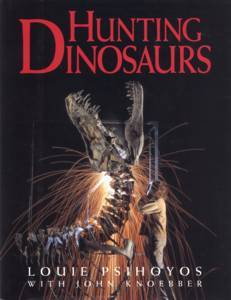

| Click on a book's image or title to order from Amazon.com |

Hunting Dinosaurs
by Louie Psihoyos with John KnoebberRandom House, © 1994
ISBN #0-679-43124-1
Psihoyos is a photographer who's done a lot of work for National Geographic. This book apparently began as a magazine assignment, and ended up as a very nice hardcover book of photojournalism about the state of paleontology today. Psihoyos seems to have had some remarkable luck in running into some late-breaking stories while preparing this book, and it turns out to be a very worthwhile effort.
The best part of the book is at the very beginning: When Psihoyos and Knoebber began their work, they learned that one of the great paleontologists of the 19th century had bequeathed his body to science, and that his bones were still on file at a nearby university. So, what did these intrepid researchers do but borrow the bones of Mr. Edward Drinker Cope and carry them around with him for the next three years! Better yet, it turns out that Cope is an idol of many living bone hunters, so Cope turned out to be a great guide for the pair through the paleontological world. Cope eventually ended up being named the type specimen for Homo Sapiens, as the book relates.
But the rest of the book is fascinating as well, once Psihoyos gets into the real subjects: the dinosaurs. He spends time with a researcher working on tracing the ancestors of the dinosaurs, and some of the improbable, wonderful luck he's had in his work. He interviews a number of sauropod hunters - the guys who go after the really big plant-eaters, like Brontosaurus. One man with a particularly distinguished career in this line of work not only filled up his university's museum, but the space under the stands in the football stadium are filled with a hundred tons of bones still waiting to be processed.
Psihoyos interviews several people who support the theory of the dinosaur-bird link. One man feels that the battle has been won, but some people just haven't accepted it yet: He states conclusively that birds are dinosaurs.
Several dinosaur trackers - people who study the fossilized tracks of dinosaurs - are interviewed. One fascinating tidbit here is that pieces of land which had once been horizontal and contain dinosaur tracks have, in the intervening time, been pushed up into mountains to become vertical. Psihoyos presents several striking photos of people scaling cliffs to examine tracks that look like they were made by some creature walking up or down the sheer face of rock.
And Psihoyos interviews people about the late evolution of dinosaurs (such as the period when South America was separate from the rest of the world and evolved some creatures not found elsewhere), and about the extinction theories. Some scientists feel that weUll never really know what killed them off, but several seem decidedly unconvinced by the asteroid theory. Psihoyos also stumbled upon scientists who had found one of the best-preserved Tyrannosaurs yet, but the FBI confiscated it for what seemed like rather spurious reasons.
Best of all, though, the book is loaded with photos of people, places, and fossils from around the world, and neatly annotated with hundreds of facts and details that I hadn't known. While I'm sure no one would claim that this book is the definitive tome on modern dinosaurology, it is nonetheless a great work nonetheless: A fresh, exciting look at a fascinating science.
hits since 13 August 2000.